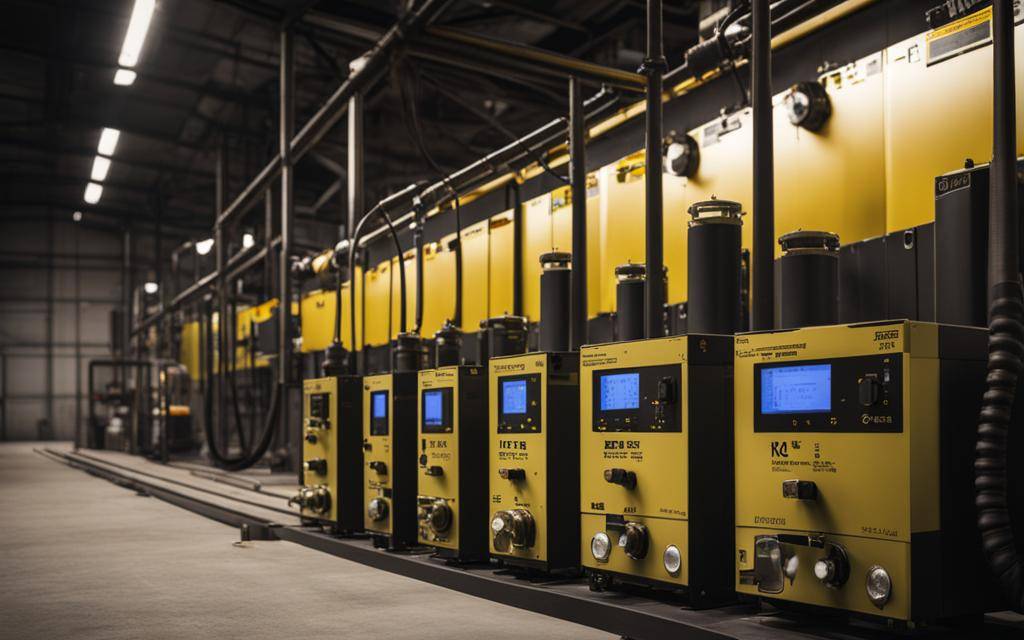A 4 gas monitor is a device used to detect the presence of certain gases in the environment. It is commonly used in hazardous environments to ensure the safety of workers. The gases typically detected by a 4 gas monitor include oxygen, combustible gases, carbon monoxide, and hydrogen sulfide. These gases are commonly encountered in industrial settings and can pose serious risks if not monitored properly.
Having a reliable gas monitor is essential for protecting workers from potential hazards. A 4 gas monitor provides real-time readings of gas levels, allowing workers to take necessary precautions and prevent accidents. It helps in monitoring oxygen levels, which is crucial for maintaining a safe working environment. Additionally, it detects combustible gases, such as methane and propane, which can potentially cause fires or explosions. Carbon monoxide and hydrogen sulfide are highly toxic gases that need to be monitored to ensure worker safety.
Using a 4 gas monitor offers several benefits. It is portable and lightweight, making it easy to carry and use in different areas of the workplace. The monitor also provides audible and visual alarms when gas levels exceed safe limits, ensuring prompt action. By using a 4 gas monitor, companies can comply with safety regulations and demonstrate their commitment to worker safety.
In conclusion, a 4 gas monitor is a crucial tool for maintaining a safe working environment in industries where hazardous gases are present. It helps detect and monitor gases typically encountered in industrial settings, ensuring the safety of workers. By using a 4 gas monitor, companies can comply with safety regulations, prevent accidents, and protect the well-being of their employees.
Importance of Monitoring Oxygen Levels
One of the key gases monitored by a 4 gas monitor is oxygen. Oxygen levels in the air can fluctuate, and it is crucial to ensure that the levels are within a safe range.
Low oxygen levels can lead to dizziness, confusion, and even loss of consciousness. On the other hand, high oxygen levels can increase the risk of fire and explosion. Therefore, monitoring oxygen levels is essential in maintaining a safe working environment.
A 4 gas monitor provides real-time readings of oxygen levels, allowing workers to take necessary precautions if levels deviate from the safe range. This enables prompt action to prevent accidents and ensure the well-being of individuals present in hazardous environments.
Detecting Combustible Gases
Combustible gases, such as methane and propane, can be present in many industrial settings. These gases have the potential to ignite and cause fires or explosions if not detected and controlled. A 4 gas monitor is equipped with sensors that can detect the presence of combustible gases in the air. By continuously monitoring the levels of these gases, workers can be alerted to the presence of a potential hazard and take appropriate action to prevent accidents.
When it comes to ensuring the safety of workers in hazardous environments, detecting combustible gases is of utmost importance. A 4 gas monitor with reliable sensors can be a lifesaver in preventing disasters. Equipped with cutting-edge technology, a 4 gas monitor can accurately detect the presence of combustible gases, such as methane and propane, in the environment. This early detection capability is crucial because it allows workers to take immediate action and mitigate the risks associated with combustible gases.
“The safety of our workers is our highest priority. With the help of a 4 gas monitor, we can detect combustible gases in real-time, ensuring the well-being of our employees and preventing potential accidents.” – John Davis, Health and Safety Manager at ABC Industries.
Using advanced sensors and algorithms, a 4 gas monitor constantly analyzes the air for the presence of combustible gases. When the concentration of these gases exceeds safe levels, the monitor triggers audible and visual alarms, alerting workers to evacuate the area or take necessary precautions. This instant notification empowers workers to respond quickly, preventing catastrophic events and safeguarding lives.
Key Features of a 4 Gas Monitor for Detecting Combustible Gases
- Precision sensors that can accurately detect low concentrations of combustible gases
- Real-time monitoring and instant alerts for immediate action
- Robust construction and durability to withstand harsh industrial environments
- User-friendly interface for easy operation and data interpretation
- Portable and lightweight design for greater flexibility and convenience
By investing in a reliable 4 gas monitor, companies can fulfill their duty to provide a safe working environment for their employees. The timely detection of combustible gases, coupled with quick response measures, can significantly reduce the risk of accidents and protect lives. Remember, prevention is always better than cure, and a 4 gas monitor plays a crucial role in preventing the ignition of combustible gases and ensuring the well-being of workers.
Monitoring Carbon Monoxide Levels
Carbon monoxide (CO) is a highly toxic gas that can be deadly if inhaled in high concentrations. It is a colorless and odorless gas that is produced by the incomplete combustion of fuels. In industries that use combustion engines or produce carbon monoxide as a byproduct, it is essential to monitor the levels of this gas to ensure the safety of workers.
A 4 gas monitor is a reliable device that can detect and measure carbon monoxide levels in real-time. By continuously monitoring the environment, it provides early detection of high concentrations of carbon monoxide, allowing prompt action to protect workers from the harmful effects of this gas.
With a 4 gas monitor, industries can ensure compliance with safety regulations and maintain a safe working environment. By implementing a proactive approach to monitoring carbon monoxide levels, companies can prevent accidents and protect the health and well-being of their employees.
Detecting Hydrogen Sulfide
Hydrogen sulfide is a highly toxic gas commonly found in industries such as oil and gas, mining, and wastewater treatment. This dangerous gas has a distinctive rotten egg odor and can pose serious health risks, including respiratory problems and even death.
A 4 gas monitor is specifically designed to detect and measure hydrogen sulfide levels in the air. By continuously monitoring the levels of this gas, workers can be promptly alerted to potential hazards and take appropriate measures to protect themselves and others in the vicinity.
Having a reliable 4 gas monitor is crucial in industries where hydrogen sulfide is present, as it allows for early detection and immediate action. It ensures that workers are aware of any dangerous levels of hydrogen sulfide, enabling them to respond quickly and appropriately to mitigate risks and prevent accidents.
By using a 4 gas monitor to detect hydrogen sulfide, companies demonstrate their commitment to ensuring the safety and well-being of their employees. It is an essential tool that provides peace of mind and safeguards against the harmful effects of this toxic gas.
Benefits of Using a 4 Gas Monitor
Using a 4 gas monitor in hazardous environments offers several benefits. Firstly, it provides real-time monitoring of gas levels, allowing for immediate response in case of any abnormalities. This can help to prevent accidents and ensure the safety of workers. Additionally, a 4 gas monitor is portable and lightweight, making it easy to carry and use in different areas of the workplace. It also offers audible and visual alarms to alert workers when gas levels exceed safe limits.
Overall, the use of a 4 gas monitor is crucial for maintaining a safe working environment in industries where hazardous gases are present.
Compliance with Safety Regulations
Compliance with safety regulations is of utmost importance in industries that handle hazardous gases. These regulations are in place to protect workers from potential exposure and ensure their safety. One of the requirements set by these regulations is the use of gas monitors to detect and monitor the presence of hazardous gases in the environment.
A 4 gas monitor is a valuable tool that helps companies comply with these safety regulations. It is designed to detect and measure the levels of various gases, including oxygen, combustible gases, carbon monoxide, and hydrogen sulfide. By using a 4 gas monitor, companies can ensure that they are meeting the specific requirements for monitoring these gases as specified by the regulations.
Compliance with safety regulations not only safeguards the well-being of workers but also demonstrates a company’s commitment to prioritizing safety. Failure to comply with these regulations can result in fines, penalties, and reputational damage. Therefore, it is crucial for companies to invest in reliable 4 gas monitors and ensure their proper use and maintenance.
Regular calibration and maintenance of the gas monitors are essential to ensure accurate readings and reliable performance. Calibration involves adjusting the device to ensure that it provides accurate measurements. This should be carried out by trained professionals according to the manufacturer’s guidelines.
Additionally, regular maintenance and sensor replacement are necessary to keep the gas monitor in optimal condition. This helps to prevent any malfunctions or inaccuracies in the readings, ensuring the continued safety of workers.
In conclusion, compliance with safety regulations is crucial in industries where hazardous gases are present. The use of a 4 gas monitor helps companies meet these regulations by accurately detecting and monitoring the levels of gases such as oxygen, combustible gases, carbon monoxide, and hydrogen sulfide. By ensuring compliance and regular calibration and maintenance of the gas monitor, companies can prioritize worker safety, avoid potential fines or penalties, and maintain a positive safety record.
Conclusion
A 4 gas monitor is an essential tool for ensuring the safety of workers in hazardous environments. By monitoring the levels of gases typically detected in industrial settings, such as oxygen, combustible gases, carbon monoxide, and hydrogen sulfide, workers can be alerted to potential hazards and take immediate action to protect themselves.
Not only does a 4 gas monitor help maintain a safe working environment, but it also ensures compliance with safety regulations. Many industries are required to use gas monitors to protect workers from exposure to hazardous gases. By using a 4 gas monitor and meeting these regulations, companies demonstrate their commitment to worker safety and avoid potential fines or penalties.
The benefits of using a 4 gas monitor cannot be overstated. With real-time monitoring, workers can respond quickly to abnormal gas levels, preventing accidents and ensuring their well-being. The portability of a 4 gas monitor allows for easy use in different areas of the workplace. Additionally, audible alarms provide an immediate alert when gas levels exceed safe limits.
Overall, a 4 gas monitor is a crucial device for safeguarding the well-being of workers in industries where hazardous gases are present. Its importance in monitoring gases, compliance with safety regulations, and the numerous benefits it offers make it an indispensable tool for maintaining worker safety and preventing accidents.
Source Links
- https://neworleanscitybusiness.com/blog/2023/12/13/smiledirectclub-is-shutting-down-where-does-that-leave-its-customers/
- https://ksltv.com/607612/retired-nypd-cops-visit-martin-luther-king-jr-s-birth-home-help-stop-alleged-would-be-arsonist/
- https://turnto10.com/i-team/consumer-advocate/return-office-plans-forcing-remote-workers-to-make-difficult-choices-mortgage-homes-rates-state-move-employer-child-care-december-13-2023

